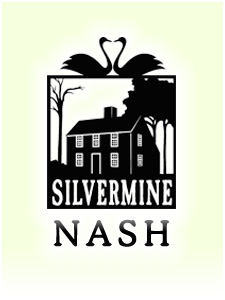In the late 19th century, the American Renaissance, an arts movement that began at America’s centennial celebration, was producing a large number of artists, writers and actors who were creating summer colonies, particularly in the northeastern United States. Beginning in the early 20th century, Silvermine, a rural mill community, grew into an important arts center. The founding of the arts community in Silvermine can be traced back to Solon Hannibal Borglum’s (1868-1922) establishment of ‘Rocky Ranch’ in Silvermine. Borglum was born in Utah prior to statehood and later spent his young adulthood as a cowboy in California and Nebraska. After studying art in Cincinnati from 1895-1897, Borglum won fame in Paris by creating sculptures of horses that personified the wildness of the western United States. After moving to New York City at the height of his international acclaim in 1899, Borglum relocated to Silvermine in 1906 to one of the former Buttery houses on what is now Borglum Road (located just north of the Silvermine Center Historic District). His property, which he christened ‘Rocky Ranch,’ included one of the Buttery family barns which he converted into a studio, as well as a mid-19th century farmhouse. Within a year of Borglum’s move, several of his peers and colleagues visited Silvermine, with some taking up at least part-time residence. The nucleus of this collection of artists in 1907, many of whom became lifelong friends and collaborators, was impressive: Edmund Ashe (1867-1941), a painter and illustrator; George Alfred Avison (1885-1970), an illustrator and muralist from Norwalk; Hamilton Hamilton (1847-1928), the renowned landscape painter, portraitist and illustrator; Howard Hildebrandt (1872-1958), a prize-winning portraitist; Addison T. Millar (1860-1913), affiliated with the Art Students League in New York City and a painter and etcher; Charles Shackleton (1856-1920), a landscape artist known for his coastal views of New England; and Henry Grinnell Thomson (1850-1937), a painter who studied with one of the preeminent American artists of the second half of the 19th century, William Merritt Chase. Those who came soon after included Lowell Leroy “Tony” Balcom (1887-1938), an etcher, painter and illustrator; Daniel Putnam Brinley (1879-1963), great-great grandson of Israel Putnam, a Revolutionary War general, a Modernist painter with intimate knowledge of the Cos Cob artist’s colony where he grew up; Richard Buckner Gruelle (1851-1914), a landscape painter known for his bucolic paintings and the father of Johnny Gruelle (1880-1938), creator of Raggedy Ann and Andy; Bernard Gutmann (1869-1936) , a painter, etcher and printmaker; Helen Hamilton (1889-1970), daughter of Hamilton Hamilton and known as a post-Impressionist painter; Frank Townsend Hutchens (1869-1937), a nationally prominent landscape and portrait painter; George Picknell (1864-1943), an illustrator and landscape painter; and Charles Reifell (1862-1942), a Modernist landscape painter and lithographer. Many of these artists already knew each other from showing at the 1913 Armory Show in New York City, studying at the Art Students League or sharing exhibitions from San Francisco to Paris. In the summer of 1907, Borglum began having critiques with other artists in his barn, which he had converted into a studio. The subsequent weekly events led to an annual show, which ran from 1907 to 1920. Originally calling themselves “The Knockers” for the barrage of criticisms they heaped upon each other, they soon were known as The Silvermine Group of Artists. These weekly sessions were anything but casual. As observed in the Christian Science Monitor on September 4th, 1915, However vague and undefined as a geographical locality the place called Silvermine, Connecticut may be, there is nothing undefined or vague about the Silvermine Group of Artists. This group is a very definite thing, simply organized, with its purpose clearly stated, holding weekly meetings, admitting to membership only professional artists, and requiring for admission of new members a unanimous vote, maintaining independence, needing no patronage nor asking any. Its weekly meetings held in the hilltop studio of Solon Borglum, the sculptor, are not for relaxation. On the contrary, the member who brings his work to these meetings, as all members are not privileged to do, knows that he is sure of frank and competent criticism, which while it may not augment self-esteem it is very likely to result in self-improvement…There is therefore no lack of good pictures for the jury to select from when the time comes for the annual exhibition. Another important social gathering point for the Silvermine Group of Artists was the creation of the Village Room. Clifton Meek, one of the leaders, started a series of readings at Borglum’s barn. Eventually, these readings became the basis for the Village Room, which moved to Bernhard Gutmann’s barn in 1915 and later to Rider’s White Mill (later relocated) (Photo #2). These regular ‘coffeehouse’-type get-togethers soon turned into something more organized and civic-minded, with intention of creating improvements in Silvermine. The first president of the group was John S. Guthrie, who at the time still owned much of the land and buildings in the center of Silvermine. To that effect, member Richardson Wright created what is described as a “Garden at the Four Cross Roads.” It is believed that the Village Room is the direct predecessor of the Silvermine Community Association. Many other artists were associated with the Silvermine Group of Artists. The rural atmosphere of the area, as well as its relatively inexpensive houses, mills and barns, were critical to the growth of the artists colony to sustain itself and grow.
